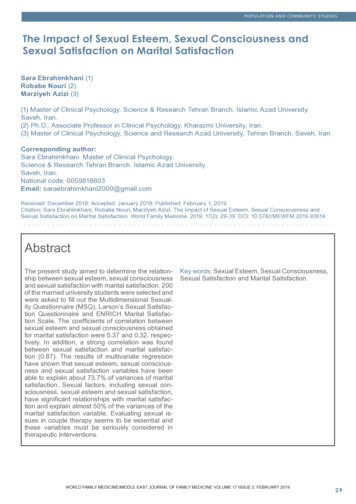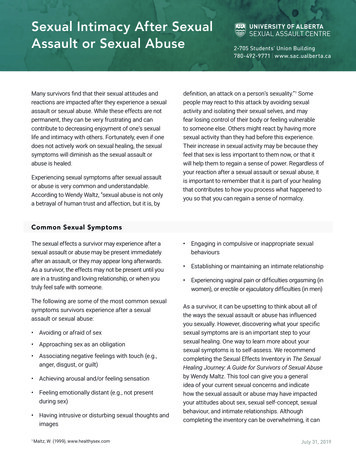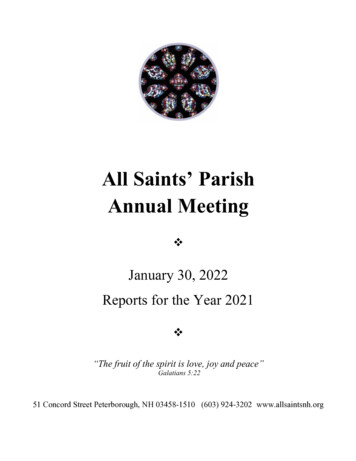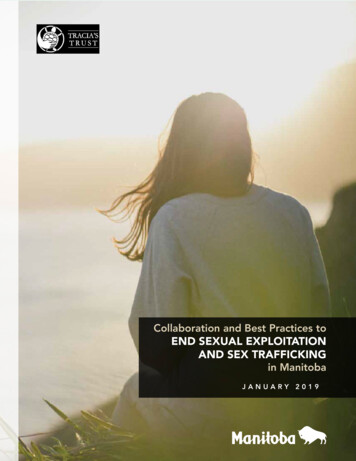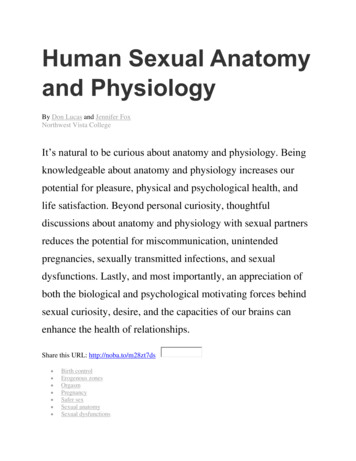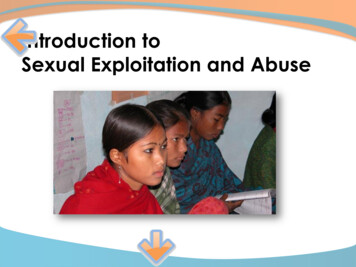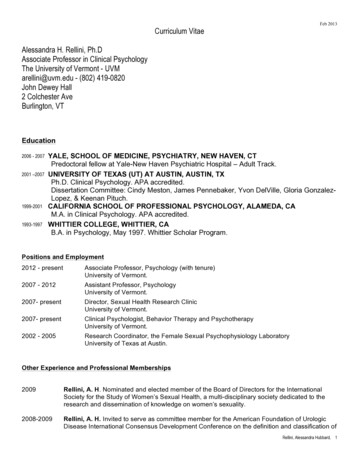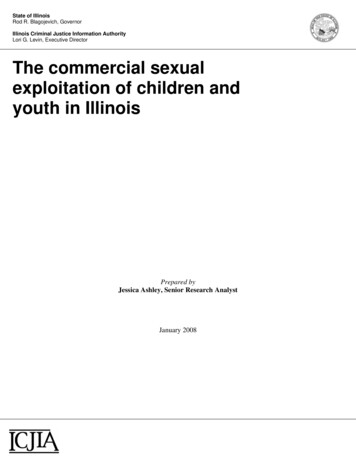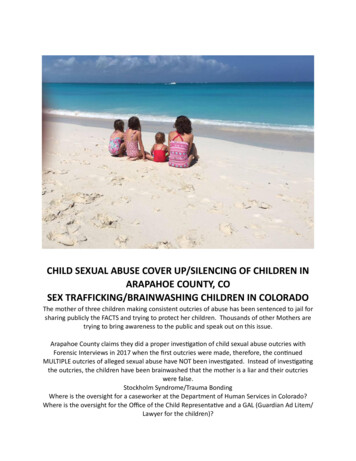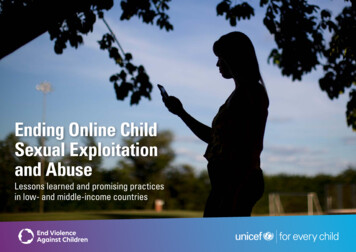
Transcription
Ending Online ChildSexual Exploitationand AbuseLessons learned and promising practicesin low- and middle-income countries
This publication has been produced with financial support from theEnd Violence Fund. However, the opinions, findings, conclusions, andrecommendations expressed herein do not necessarily reflect those of theEnd Violence Fund.Suggested citation: United Nations Children’s Fund (2021) Ending onlinechild sexual exploitation and abuse: Lessons learned and promisingpractices in low- and middle-income countries, UNICEF, New York United Nations Children’s Fund (UNICEF) December 2021.Permission is required to reproduce any part of this publication. Permissionwill be freely granted to educational or non-profit organizations. For moreinformation on usage rights, please contact: nyhqdoc.permit@unicef.orgDesign and layout: Big Yellow Taxi, Inc.Cover Photo: UNICEF/UN017601/Ueslei MarcelPublished by UNICEF Child Protection Team, Programme Group, 3 UnitedNations Plaza, New York, NY 10017. Email: childprotection@unicef.orgWebsite: www.unicef.orgCHILD PROTECTION
Acronyms/DefinitionsContentsExecutiveSummary1. Introduction2. Overview3. Case StudiesContentsForeword. . . . . . . . . . . . . . . . . . . . . . . . . . . . . . . . . . . . . . . . . . . . . . . . . . . . . . . . . . . . . . . . . . . . . . . . . . . . . . . . . 2Acknowledgements. . . . . . . . . . . . . . . . . . . . . . . . . . . . . . . . . . . . . . . . . . . . . . . . . . . . . . . . . . . . . . . . . 3Acronyms. . . . . . . . . . . . . . . . . . . . . . . . . . . . . . . . . . . . . . . . . . . . . . . . . . . . . . . . . . . . . . . . . . . . . . . . . . . . . . . . 4Definitions. . . . . . . . . . . . . . . . . . . . . . . . . . . . . . . . . . . . . . . . . . . . . . . . . . . . . . . . . . . . . . . . . . . . . . . . . . . . . . . 5Executive Summary. . . . . . . . . . . . . . . . . . . . . . . . . . . . . . . . . . . . . . . . . . . . . . . . . . . . . . . . . . . . . . . . . 7PA R T ONEIntroduction. . . . . . . . . . . . . . . . . . . . . . . . . . . . . . . . . . . . . . . . . . . . . . . . . . . . . . . . . . . . . . . . . . . . . . . . . . . 13Objectives and structure of the report. . . . . . . . . . . . . . . . . . . . . . . . . . . . . . . . . . . . . . . . . . . . . . . . . . . . . . . . . . . . 15PA R T T WOOverview of national responses to technology-facilitatedchild sexual exploitation and abuse. . . . . . . . . . . . . . . . . . . . . . . . . . . . . . . . . . . . . . . . . 182.1 Overview of the Model National Response. . . . . . . . . . . . . . . . . . . . . . . . . . . . . . . . . . . . . . . . . . . . . . . . . . . 182.2 Policy and governance. . . . . . . . . . . . . . . . . . . . . . . . . . . . . . . . . . . . . . . . . . . . . . . . . . . . . . . . . . . . . . . . . . . . . . . . 192.3 Criminal justice. . . . . . . . . . . . . . . . . . . . . . . . . . . . . . . . . . . . . . . . . . . . . . . . . . . . . . . . . . . . . . . . . . . . . . . . . . . . . . 262.4 Victim. . . . . . . . . . . . . . . . . . . . . . . . . . . . . . . . . . . . . . . . . . . . . . . . . . . . . . . . . . . . . . . . . . . . . . . . . . . . . . . . . . . . . . . . 322.5 Societal. . . . . . . . . . . . . . . . . . . . . . . . . . . . . . . . . . . . . . . . . . . . . . . . . . . . . . . . . . . . . . . . . . . . . . . . . . . . . . . . . . . . . . 402.6 Industry. . . . . . . . . . . . . . . . . . . . . . . . . . . . . . . . . . . . . . . . . . . . . . . . . . . . . . . . . . . . . . . . . . . . . . . . . . . . . . . . . . . . . . 462.7 Media and communication. . . . . . . . . . . . . . . . . . . . . . . . . . . . . . . . . . . . . . . . . . . . . . . . . . . . . . . . . . . . . . . . . . . 504. COVID-195. Gaps andChallenges6. WayForwardBibliographyClick on section bars tonavigate publicationPA R T T HREECase studies . . . . . . . . . . . . . . . . . . . . . . . . . . . . . . . . . . . . . . . . . . . . . . . . . . . . . . . . . . . . . . . . . . . . . . . . . 533.1 Albania: Innovation and convening power. . . . . . . . . . . . . . . . . . . . . . . . . . . . . . . . . . . . . . . . . . . . . . . . . . . 543.2 Dominican Republic: Strengthening governance. . . . . . . . . . . . . . . . . . . . . . . . . . . . . . . . . . . . . . . . . . . 563.3 Namibia: A multisectoral approach. . . . . . . . . . . . . . . . . . . . . . . . . . . . . . . . . . . . . . . . . . . . . . . . . . . . . . . . . . 583.4 Philippines: A systems approach and private sector engagement. . . . . . . . . . . . . . . . . . . . . . . . . . 60PA R T F OURAddressing technology-facilitated child sexual exploitationand abuse in the face of COVID-19 . . . . . . . . . . . . . . . . . . . . . . . . . . . . . . . . . . . . . . . . . . 63PA R T F I V EOverall gaps and challenges in progress made against theModel National Response. . . . . . . . . . . . . . . . . . . . . . . . . . . . . . . . . . . . . . . . . . . . . . . . . . . . . . . 66PA R T SI XLessons learned and way forward. . . . . . . . . . . . . . . . . . . . . . . . . . . . . . . . . . . . . . . . . . . 68Bibliography. . . . . . . . . . . . . . . . . . . . . . . . . . . . . . . . . . . . . . . . . . . . . . . . . . . . . . . . . . . . . . . . . . . . . . . . . . 76Appendices. . . . . . . . . . . . . . . . . . . . . . . . . . . . . . . . . . . . . . . . . . . . . . . . . . . . . . . . . . . . . . . . . . . . . . . . . . . . 77Appendix 1: Preventing and Tackling Child Sexual Exploitation and Abuse: A ModelNational Response . . . . . . . . . . . . . . . . . . . . . . . . . . . . . . . . . . . . . . . . . . . . . . . . . . . . . . . . . . . . . . . . . . . . . . . . . . . . 77Appendix 2: Country Office Survey on National Response to Online Child SexualExploitation and Abuse. . . . . . . . . . . . . . . . . . . . . . . . . . . . . . . . . . . . . . . . . . . . . . . . . . . . . . . . . . . . . . . . . . . . . . . . 78Appendix 3: Status of ratification of key international instruments. . . . . . . . . . . . . . . . . . . . . . . . . . . . . 87Appendix 4: Country snapshots by Model National Response domain. . . . . . . . . . . . . . . . . . . . . . . . . . 89Endnotes. . . . . . . . . . . . . . . . . . . . . . . . . . . . . . . . . . . . . . . . . . . . . . . . . . . . . . . . . . . . . . . . . . . . . . . . . . . . . 1021Ending online child sexual abuse and exploitationAppendices
Acronyms/DefinitionsContentsExecutiveSummary1. Introduction2. Overview3. Case Studies4. COVID-195. Gaps andChallenges6. WayForwardBibliographyForewordI’m pleased to present this report, which takes stock of UNICEF’s work toaddress online child sexual exploitation and abuse in 29 countries aroundthe world.As set out in our Child Protection Strategy 2021-2030, we are stepping upour efforts to support governments, the technology industry, civil society,and other stakeholders to address new child protection challenges posedby the digital environment.The rapid expansion of digital technology has transformed childrenand young people’s lives in all corners of the world. As affirmed bythe Committee on the Rights of the Child in General Comment No. 25released this year, digital technologies present tremendous potential torealize children’s rights. This has become even more apparent during theCOVID-19 pandemic and corresponding lockdown measures, during whichdigital technology was a lifeline for many children to continue to learn,play, and socialize.At the same time, we know that perpetrators are using digital technologiesto access and harm children. Year on year, there are increases in reportsof online child sexual abuse content. As digital technology becomes moreubiquitous, it is increasingly connected with cases of child sexual abuseand exploitation. For example, perpetrators use technology to contact andgroom children, to coerce children to create sexual images and videos,and/or to record their sexual abuse of children. In tackling cases of childsexual exploitation and abuse, we must consider actual or potential digitalimplications and in considering children’s safety online, we must considerpotential risks of online child sexual exploitation and abuse.2Ending online child sexual abuse and exploitation“Year on year, there are increases in reportsof online child sexual abuse content. Asdigital technology becomes more ubiquitous,it is increasingly connected with cases ofchild sexual abuse and exploitation.”An increasing number of nations have acknowledged this reality and takenimportant steps to protect children in the digital age. Many countrieshave been motivated through their membership of the WeProtect GlobalAlliance, initially established in 2014. In implementing coordinated andcomprehensive action, countries have also been guided by WeProtect’sModel National Response framework.We thank the End Violence Fund for the financial support todocument UNICEF’s experience in this work through partnership withgovernments, industry, and civil society in over two-dozen countries.We are also pleased that this research will feed into an upcoming reportto be published by the WeProtect Global Alliance about how the ModelNational Response is supporting national efforts to end online childsexual exploitation and abuseOur dedicated and joint efforts have resulted in significant progress andlearning. This report illustrates advances in, for instance, the availabilityof multisectoral governance mechanisms and stronger legislation tocriminalize online child sexual exploitation and abuse. We are seeingAppendices
Acronyms/DefinitionsContentsExecutiveSummary1. Introduction2. Overviewimportant efforts to systematically strengthen the availability and skillsof critical professional cadres in social services, law enforcement,judiciary, and prosecution.While acknowledging these advancements, in many low- and middleincome countries, significant systemic issues remain that leave childrenat higher risk of online sexual exploitation and abuse and less likely toreceive appropriate support and assistance if they experience abuse.This report makes the case for increased investment in regular andquality data to inform national policies, strategies and programmes,strengthened support services and responses, improved knowledgeand skills on child sexual abuse prevention among parents,communities and children, and meaningful engagement of childrenand young people in building systems and driving accountability.The ever-present nature of the digital environment, critical challengesfaced by child protection systems worldwide, and the ongoing globalCOVID-19 pandemic, make this more urgent than ever before. UNICEFis committed to accelerating this work with our partners, with a focuson preventing the abuse in the first place, so that every child can live alife free from sexual exploitation and abuse.Cornelius WilliamsDirector of Child ProtectionUNICEF3Ending online child sexual abuse and exploitation3. Case Studies4. COVID-195. Gaps andChallenges6. WayForwardBibliographyAcknowledgementsThis report was written by Dr Maxi Ussar with technical guidance andsupport provided by Afrooz Kaviani Johnson, Child Protection Specialist,and Stephen Blight, Senior Child Protection Adviser, Child ProtectionTeam, Programme Group, UNICEF Headquarters in New York.Special thanks go to UNICEF country office colleagues and partnersin Albania, Algeria, Belarus, Bosnia and Herzegovina, Brazil, Bulgaria,Cambodia, China, Colombia, Dominican Republic, Egypt, El Salvador,Ghana, Guatemala, Indonesia, Jordan, Kenya, Madagascar, Mongolia,Montenegro, Namibia, Nepal, Paraguay, Philippines, Rwanda, Serbia,South Africa, Viet Nam and Zimbabwe, who provided valuableinsights, responded to the survey for the study, submitted documentsfor review and commented on earlier versions of the report. Thanksgo also to colleagues in UNICEF’s regional offices, Office of Research,Child Rights and Business Unit and Child Protection Team, ProgrammeGroup for their helpful input and feedback on the report.UNICEF gratefully acknowledges the financial support provided for thisstudy by the End Violence Fund.Appendices
Acronyms/DefinitionsContentsExecutiveSummary1. Introduction2. OverviewAcronyms4ASEANAssociation of South East Asian NationsCSEAChild Sexual Exploitation and AbuseCSOCivil Society OrganisationCRCConvention on the Rights of the ChildCSRCorporate Social ResponsibilityEAPROEast Asia and Pacific Regional OfficeGBVGender-based ViolenceICTInformation Communication TechnologyICSE databaseInternational Child Sexual Exploitation databaseINTERPOLInternational Criminal Police OrganizationISPInternet service providerLMICsLow and middle-income countriesNGONon-governmental organisationMNRModel National ResponseNCMECNational Center for Missing and Exploited ChildrenUKUnited KingdomUNICEFUnited Nations Children’s FundUNODCUnited Nations Office on Drugs and CrimeEnding online child sexual abuse and exploitation3. Case Studies4. COVID-195. Gaps andChallenges6. WayForwardBibliographyAppendices
Acronyms/DefinitionsContentsExecutiveSummary1. Introduction2. Overview3. Case Studies4. COVID-195. Gaps andChallenges6. WayForwardBibliographyDefinitions5TERM (SOURCE)DEFINITIONTERM (SOURCE)DEFINITIONAdolescentWorld Health OrganisationChildren and young people in the transitional phasebetween childhood and adulthood, those aged 10–19 years.Association of South EastAsian NationsASEAN is a regional grouping that promotes economic,political and security cooperation among its 10 members:Brunei, Cambodia, Indonesia, Lao PDR, Malaysia, Myanmar,the Philippines, Singapore, Thailand and Viet Nam.ChildArticle 1, Convention on theRights of the Child (CRC),United Nations 1989Any human being under the age of 18 years, unlessunder the law applicable to the child, majority isattained earlier.Child protectionUNICEF uses the term ‘child protection’ to refer toprevention and response to violence, exploitation andabuse of children in all contexts.Child sexual abusematerialCommittee on the Rightsof the Child, Guidelinesregarding the implementationof the Optional Protocol tothe Convention on the Rightsof the Child on the sale ofchildren, child prostitution andchild pornography, CRC/C/156,10 September 2019, para 60Child sexual abuse material is covered under article 2 of theOptional Protocol to the CRC on the sale of children, childprostitution and child pornography as ‘child pornography’,and is defined as any representation, by whatever means, ofa child engaged in real or simulated explicit sexual activitiesor any representation of the sexual parts of a child forprimarily sexual purposes (art. 2 (c)) .The Committee on the Rights of the Child recommendsthat States’ parties, in line with recent developments,avoid the term ‘child pornography’ to the extent possibleand use other terms such as the ‘use of children inpornographic performances and materials’, ‘child sexualabuse material’ and ‘child sexual exploitation material’.Child sexual exploitationand abuseArticle 18, Council of EuropeConvention on the Protectionof Children against SexualExploitation and Sexual Abuse(Lanzarote Convention)ECPAT. Terminology Guidelinesfor the Protection of Childrenfrom Sexual Exploitation andSexual Abuse. Adopted by theInteragency Working Group inLuxembourg, 28 January 2016See also: Committee on theRights of the Child, Guidelinesregarding the implementationof the Optional Protocol tothe Convention on the Rightsof the Child on the sale ofchildren, child prostitution andchild pornography, CRC/C/156,10 September 2019Child sexual abuse includes:(a) Engaging in sexual activities with a child who,according to the relevant provisions of national law,has not reached the legal age for sexual activities (thisdoes not apply to consensual sexual activities betweenminors), and(b) engaging in sexual activities with a child where use ismade of coercion, force or threats; or abuse is made of arecognized position of trust, authority or influence overthe child, including within the family; or abuse is madeof a particularly vulnerable situation of the child, notablybecause of a mental or physical disability or a situationof dependence.Child sexual abuse becomes sexual exploitation whena second party benefits monetarily, through sexualactivity involving a child. It includes harmful acts suchas sexual solicitation and sexual exploitation of a child oradolescent in prostitution and, in the Council of EuropeConvention, covers situations in which a child or otherperson is given or promised money or other form ofremuneration, payment or consideration in return for thechild engaging in sexual activity, even if the payment/remuneration is not made.Although the terms are sometimes used interchangeably,what distinguishes the concept of child sexualexploitation from child sexual abuse is the underlyingnotion of exchange.Ending online child sexual abuse and exploitationAppendices
Acronyms/DefinitionsContents6ExecutiveSummary1. Introduction2. Overview3. Case Studies4. COVID-195. Gaps andChallenges6. WayForwardBibliographyTERM (SOURCE)DEFINITIONTERM (SOURCE)DEFINITIONChild traffickingArticle 3, Protocol to Prevent,Suppress and Punish Traffickingin Persons, especially Womenand Children, Supplementingthe United Nations Conventionagainst TransnationalOrganized Crime (PalermoProtocol), United Nations (2000)The recruitment and/or transport, transfer, harbouringand receipt of a child by others with the intent ofexploiting the child through various means, for example,but not limited to, prostitution, begging and child labour.Online solicitation (orgrooming) of a child forsexual purposesArticle 23, LanzaroteConventionIntentional proposal, through information andcommunication technologies, of an adult to meet a childwho has not reached the legal age for sexual activities,for the purpose of engaging in sexual activities or theproduction of child sexual abuse materials.Technology industryITU. Guidelines for industry onChild Online Protection, 2020Livestreaming child sexualexploitation and abuseTransmitting child sexual abuse and exploitation in realtime over the internet. This occurs on online chat rooms,social media platforms, and communication apps withvideo chat features. Viewers of livestreaming childsexual abuse can be passive (pay to watch) or active bycommunicating with the child, the sexual abuser and/or facilitator of the child sexual abuse, and requestingspecific physical acts. Another form of livestreaming caninvolve coercing a child to produce and transmit sexualmaterial in real-time.Online child exploitationand abuse (also referredto in this report astechnology-facilitatedchild sexual exploitationand abuse)ECPAT. Terminology Guidelinesfor the Protection of Childrenfrom Sexual Exploitation andSexual Abuse. Adopted by theInteragency Working Group inLuxembourg, 28 January 2016See also: Committee on theRights of the Child, Guidelinesregarding the implementationof the Optional Protocol tothe Convention on the Rightsof the Child on the sale ofchildren, child prostitution andchild pornography, CRC/C/156,10 September 2019There is no internationally agreed definition of onlinechild sexual exploitation and abuse. For the purposesof this document, the term is used interchangeably with‘technology-facilitated child sexual exploitation andabuse’ to refer to child sexual exploitation and abuse thatis partly or entirely facilitated by technology, that is theinternet or other wireless communications.For example, child sexual abuse takes on an onlinedimension when, for instance, acts of sexual abuseare photographed or video-/audiorecorded and thenuploaded and made available online, whether forpersonal use or for sharing with others. Each repeatedviewing and/or sharing of such recorded materialconstitutes a new violation of the rights of the child.The ICT or technology sector covers a broad range ofcompanies including but not limited to:(a) ISPs, including through fixed landline broadbandservices or cellular data services of mobile networkoperators: while this typically reflects services offeredover a more long-term basis to subscribed customers, itcould also be extended to businesses that provide free orpaid public WI-FI hotspots.(b) Social network /messaging platforms and onlinegaming platforms.(c) Hardware and software manufacturers, such asproviders of handheld devices including mobile phones,gaming consoles, voice assistance-based home devices,Internet of Things and smart Internet connected toys forchildren.(d) Companies providing digital media (content creators,providing access to or hosting content).(e) Companies providing streaming services, includinglive streams.(f) Companies offering digital file storage services,cloud-based service providers.Ending online child sexual abuse and exploitationAppendices
Acronyms/DefinitionsContentsExecutiveSummary1. Introduction2. Overview3. Case Studies4. COVID-195. Gaps andChallenges6. WayForwardBibliographyExecutive SummaryGlobally, 1 in 5 girls and 1 in 13 boys have been sexually exploitedor abused before reaching the age of 18.1 Some recent researchsuggests that online interaction is now so ubiquitous that it is likely tofeature in some form in almost all cases of child sexual exploitation andabuse. Increased internet penetration and advances in technology haveallowed offenders to engage in child sexual exploitation and abuse in anunprecedented environment of secrecy and relative anonymity acrossthe globe. While the full scope and extent of the threat of technologyfacilitated child sexual exploitation and abuse remains unknown, globalstatistics show alarming increases in reported cases to national hotlinesand clearing houses in recent years.A new sense of urgency: The COVID-19 pandemic, which brought withit increased emotional vulnerabilities, economic hardship and surges inunsupervised time online among children and adolescents2 is likely to havemagnified vulnerabilities to child exploitation and abuse, particularly online.Widespread disruptions in child protection services across the world haveleft vulnerable children without access to adequate protection, furthercontributing to a new sense of urgency to address online child sexualexploitation and abuse.The WeProtect Initiative. To tackle online child sexual abuse andexploitation globally, the UK government, with support from other nationalgovernments, leading technological companies, INTERPOL, UN agenciesand civil society organizations, established the WeProtect initiative in2014. The initiative developed the WeProtect Global Alliance ModelNational Response (MNR), which provides a comprehensive blueprint foreffectively tackling child sexual exploitation and abuse at the national level(See Appendix 1).7Ending online child sexual abuse and exploitationFigure 1: WeProtect Model National ResponsePOLICY AND GOVERNANCEHighest level national commitmentto child sexual exploitation andabuse prevention and responseSOCIETALPrevention of child sexualexploitation and abuseINDUSTRYEffective and successfulchild sexual exploitation andabuse investigations, convictionsand offender managementIndustry engaged indeveloping solutions toprevent and tackle childsexual exploitation andabuseVICTIMCOMMUNICATION AND MEDIACRIMINAL JUSTICEAppropriate support services forchildren and young peopleAwareness raised amongthe public, professionalsand policymakersRationale and methodologyUNICEF has been working with its partners to address child sexual exploitationand abuse, including technology-facilitated child sexual exploitation and abuse,through a comprehensive systems approach. This work intensified from2015 through the implementation of a Global Programme to build capacity ofgovernments, civil society and the private sector to tackle technology-facilitatedchild sexual exploitation. The first phase of the Global Programme, fundedby the UK government, was implemented in 17 countries across 4 regions,3and was expanded in its second phase starting in 2018 with support from theGlobal Partnership to End Violence against Children.Over five years into the roll-out of the UNICEF Global Programme, this reporttakes stock of the current level of implementation of the MNR across selectedcountries, and identifies promising practices and lessons learned. The reportAppendices
Acronyms/DefinitionsContentsExecutiveSummary1. Introduction2. Overview3. Case Studiesprimarily relies on survey responses from 29 UNICEF country offices4 in lowand middle-income countries (LMICs) in all regions, as well as four field visitsand a desk review of relevant literature and documents. Given the methodsused and the breadth of the report, it does not aim to evaluate or provide acomprehensive review of the implementation of the MNR. Rather, it intends toprovide a headline overview of the current situation across target countries todraw out promising practices and lessons learned to inform future policy andpractice. The survey responses will also feed into a forthcoming global reportby the WeProtect Global Alliance on how the MNR is supporting nationalefforts to end online child sexual exploitation and abuse.BibliographyAll of the surveyed countries have law enforcementcapability with an explicit remit to respond to offlineand online child sexual exploitation and abuse. Morethan half of countries (72 per cent) that have suchcapability report it to lie with a unit responsible forcybercrimes, at times in collaboration with units specialized ininvestigating crimes against children or women. In these cases, effectivecollaboration between the different units appears to be a challenge andlinkages with child protection and victim services remains unclear.Although judiciary and prosecution services in most countries (75 per centand 79 per cent, respectively) have some knowledge and skills to enablepositive outcomes for victims of child sexual exploitation and abuse, onlyone country reports comprehensive knowledge among both prosecutors U N IC E F/UN 0367646/RAABDomain 1: Policy and governanceEnding online child sexual abuse and exploitation6. WayForwardDomain 2: Criminal justiceOverall, significant progress has been made in terms of tackling onlinechild sexual exploitation and abuse across many low- and middle-incomecountries in a relatively short period of time. Advances have particularlycentred around strengthened policy and governance frameworks;improved capacity of law enforcement, the judiciary and prosecutionservices to handle such cases; the greater availability of hotlines andhelplines for reporting, support and referral; and the increasing roll-out ofeducation and awareness raising programmes on online and offline childsexual exploitation and abuse. Despite this, significant challenges remainacross all six domains of the MNR (see Figure 2).85. Gaps andChallengesexistence of some capabilities, there remain challenges in effectivefunctioning of the governance mechanisms, limited systematic datacollection and limited use of generated evidence to inform policy andpractice, as well as constrained enforcement of legislation.Key findingsThe majority (69 per cent) of surveyed countries havesome form of national governance structure to dealwith online child sexual abuse and exploitation. Justover half (59 per cent) have a relevant national policyor strategy and most (79 per cent) have nationallyrepresentative research on child sexual exploitation and abuse, sometimesincluding online dimensions. Significant gaps remain in legislativeframeworks in the majority (90 per cent) of countries. Despite the4. COVID-19Appendices
Acronyms/DefinitionsContentsExecutiveSummary1. Introduction2. Overview3. Case Studiesand judiciary. Offender management processes is one of the leastdeveloped capabilities and more than half of all countries surveyed (57 percent) have no offender management process in place. Approximately halfof all respondent countries (48 per cent) have access to INTERPOL’sInternational Child Sexual Exploitation database.Domain 3: VictimTo provide integrated end-to-end support to victimsof child sexual exploitation and abuse, the majority ofcountries surveyed (69 per cent) have a casemanagement plan, a protocol, or applicable legislationthat outlines relevant procedures. However, effectiveimplementation of plans and procedures is a critical challenge in manycountries. Availability of a trained child protection workforce appears tobe significantly constrained, with only one of the countries surveyedreporting to have a comprehensively trained social service workforce insufficient numbers to meet demand. Only one country reports having inplace comprehensive remedies for victims of child sexual exploitation andabuse. The vast majority of countries (93 per cent) currently offer a childhelpline. Although helplines tend to be free of charge and accessible 24/7,survey findings suggest that many face human and financial resourceconstraints, as well as challenges to provide effective linkages to referralsystems.Domain 4: SocietalAlmost 90 per cent (26 countries) of all countriessurveyed have a functioning reporting hotline orreporting portal for the public to report illegal onlinecontent including child sexual abuse material.However, there are challenges to use and uptake ofhotlines, for example because of limited awareness of their existence, lackof faith in the reporting system or fear of victim-blaming. More than two9Ending online child sexual abuse and exploitation4. COVID-195. Gaps andChallenges6. WayForwardBibliographythirds of all countries surveyed (72 per cent) have a national educationprogramme to raise awareness of online and offline child sexualexploitation and approximately two-thirds of countries surveyed (64 percent) report that children and young people are, or have been, encouragedand enabled to participate in development of child sexual exploitation andabuse-related policy and practice. The most critical challenges in thisdomain relate to weak offender support systems, as the majority ofcount
4 Ending online child sexual abuse and exploitation Acronyms ASEAN Association of South East Asian Nations CSEA Child Sexual Exploitation and Abuse CSO Civil Society Organisation CRC Convention on the Rights of the Child CSR Corporate Social Responsibility EAPRO East Asia and Pacific Regional Office GBV Gender-based Violence ICT Information Communication Technology .
